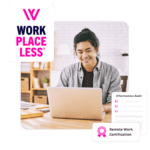
Kickstart Your Remote Career Today!
Effectively juggling the professional demands of a work-from-home lifestyle without succumbing to the ‘always-on’ mentality can be a demanding task. How to structure a work-from-home schedule might seem like a straightforward challenge, but when combined with remote career growth and a need for flexibility, it becomes a multi-faceted opportunity for personal development.
A schedule that not only enhances your productivity but also promotes well-being and growth in a remote work setting is crucial for your development as a remote professional – let’s get into it.
1. Understanding Your Remote Work Rhythm 
Discovering how to work remotely is not necessarily simple, but there is a good place to start: every individual’s natural work rhythm is their most reliable compass.
- What time of the day are you at your peak of focus and productivity?
- When do you feel most creative and inspired?
- Are there any specific times of the day when you struggle to concentrate or need a mental health break
On top of thinking about these questions, take the time to observe your energy levels and moods throughout the day for a week or two. Make note of when you feel most productive and creative. Reflect on your preferences, considering factors like the time of day, your workspace, and even your attire.
While these may seem like minor details, they can have a significant impact on your productivity while working remotely, providing subtle cues that enhance overall performance.
Mornings Are Golden (Or Not)
For some remote professionals, early mornings are the sacred hours of deep thought and uninterrupted work. For others, the silent calm of late-night hours is where creativity thrives.
In our experience, no timing is inherently superior, but understanding and embracing your peak hours can have a substantial impact on your daily output.
Creating Your Optimal Remote Work Environment
Your remote office space is more than just the physical location where you perform your duties. It sets the stage for either productive work sessions or potential distractions. Identify whether a quiet, organized home office, or a bustling coffee shop seems to spur your best work and tailor your environment accordingly.
Luckily, we’ve got a guide that digs deeper into optimizing your remote workspace to make your life easy.
TIP: Align Your Expectations with Your Schedule
A harmonious work-from-home schedule is one that aligns personal productivity peaks with professional expectations. This isn’t always easy, especially when working for clients or companies across different time zones. While this is a common challenge many remote workers face, it’s crucial to set realistic expectations with yourself and those you work with.
Flexibility, not rigidity, should be the cornerstone of your work-from-home schedule. While it’s certainly prudent to have set ‘working hours’, it’s equally important to be adaptable. Unexpected tasks and life’s difficulties can often arise, and a flexible schedule can accommodate these without derailing your work plan.
On the opposite end of the spectrum, while it’s good to be flexible, an often-overlooked aspect of scheduling is the need to set and communicate clear boundaries. This is vital for your well-being and ensures that others respect your personal time. Taking calls at midnight might seem harmless in the short run, but in the long term, it can lead to burnout (unless you determine midnight work calls are part of your flexibility).
2. Structuring Your Remote Workday for Success
One of the core benefits of working remotely comes from the ability to flexibly structure your day. To maximize this benefit, you must understand: an effective day begins with a plan. Whether you use digital task managers, wall calendars, or the trusty pen-and-paper method, having a clear structure will guide you through your day and keep you on track.
Designing Your Perfect Day
Start each day with a clear plan. Write down the three most important things you want to achieve, and ensure that these activities align with your personal and professional goals. Having a clear direction from the get-go sets a positive tone for the day.

Kickstart Your Remote Career Today!
Now that you’ve got your direction determined, you need to block – or box – some time out to get your work done.
The Power of Time Boxing
Time boxing is the practice of allocating specific time slots to tasks. It’s a method that works well for remote workers because it creates a sense of urgency and prevents tasks from expanding beyond their box to fill the available time. It’s like creating mini-deadlines for yourself throughout the day.
To get started with time boxing:
- Set clear estimates: Give an estimate on how much time each task will take. Be realistic but strict with your estimates to encourage efficiency.
- Use a calendar app: Record these time estimates into a digital calendar or another time management app.
- Set priority levels: Organize the time blocks based on priorities – place the highest priority blocks into periods where you are most productive.
- Track and review: Keep an eye on each time block. If you consistently go over the estimated time, perhaps you need to adjust how you allocate your time. Take time at the end of the week to consistently review when you were most and least productive.
Prioritizing Deep Work and Meetings
Last but certainly not least, for many, the bulk of high-impact work happens during periods of uninterrupted, ‘deep’ work. Identify these periods in your day and guard them fiercely.
Conversely, structure your meetings and other shallow work around these times. This is essential for hybrid work – having specific blocks of time for meetings or days in the office planned ahead of time will make your schedule much easier to manage.
3. Incorporating Wellness and Balance
We’ve discussed time boxing, setting aside time for specific parts of your workday, and structuring your remote work environment – let’s dig into the psychological side of things.
Wellness is not just a buzzword — it’s a critical component of sustainable productivity. A well-rounded schedule ensures you have time to not only get work done but also invest in personal development and mental and physical well-being.
Scheduling Time For Movement
Incorporate scheduled breaks and time for movement in your remote work routine. Whether it’s a midday yoga session or a post-work run, these activities can re-energize you and promote long-term health. Opt for a standing desk, if possible, to add a layer of activity to your workday.
Or, purchase a yoga mat or something else you can kneel on. You can kneel on one knee, kneel on both, stretch one leg out – the possibilities are endless. This allows you to keep some active movement in the lower half of your body, and it feels pretty nice too.
Embracing Essential Breaks
Deliberately schedule essential breaks, such as coffee or lunch, to avoid the trap of working straight through the day. This simple act can help you maintain focus and energy levels and provides a ‘reset’ between tasks.
4. Enhancing Productivity Through Routines and Rituals
Time management when working remotely can be quite tricky, but routines and rituals may be the glue that holds your work-from-home schedule together. They provide predictability and comfort, and can be tailored to meet your specific needs.
Communication and Starting and Ending Your Days
Determine rituals that signify the start and end of your workday. These can be as simple as checking in with a colleague or updating your to-do list. Clear delineations help maintain work-life balance.
In this same vein, it’s also crucial create a strategy for tackling meetings and communications. Buffer times between appointments can allow you to seamlessly transition from one task to the next; these buffers can also act as a ‘meeting reserve’ if one runs over.
5. Planning and Reflecting for Continuous Improvement
Last but certainly not least, every day is an opportunity to refine your work from home schedule. By reflecting on what worked and what didn’t, you can continually tailor your schedule to your evolving needs. This practice of self-assessment is key to long-term improvement in your remote work life, allowing you to reach a higher level of fulfillment and efficiency, if that’s something you desire.
Proactively Planning for Deadlines
Know when major projects or tasks are due and ensure they fit within your overall schedule. By having a clear view of your commitments, you can better manage your time and avoid overcommitting on any given day.
Daily Reflections on Accomplishments
Take the time at the end of the day or week to reflect on your accomplishments. Did you achieve your three most important tasks? If not, what got in the way? This practice of introspection helps refine your schedule for the next workday.
Final Thoughts
Creating an ideal work-from-home schedule is an ongoing process. What may work well today could be in need of tweaking tomorrow. By intentionally crafting a schedule that considers your natural work rhythms, aligning with expectations, and integrating wellness strategies, you can cultivate a productive and sustainable remote work life. The key is finding the balance that propels you forward in your career, while also recognizing that time spent on self-care and personal pursuits is time invested in your professional success.

Growplaceless is not just a course ABOUT career development.
Ready to take your remote career to the next level? Check out Workplaceless’s Growplaceless Virtual Career Development program for valuable resources and guidance to thrive in the remote work environment. With these strategies and a willingness to adapt as needed, you can transform your work-from-home routine from a source of stress into a wellspring of growth and opportunity.








